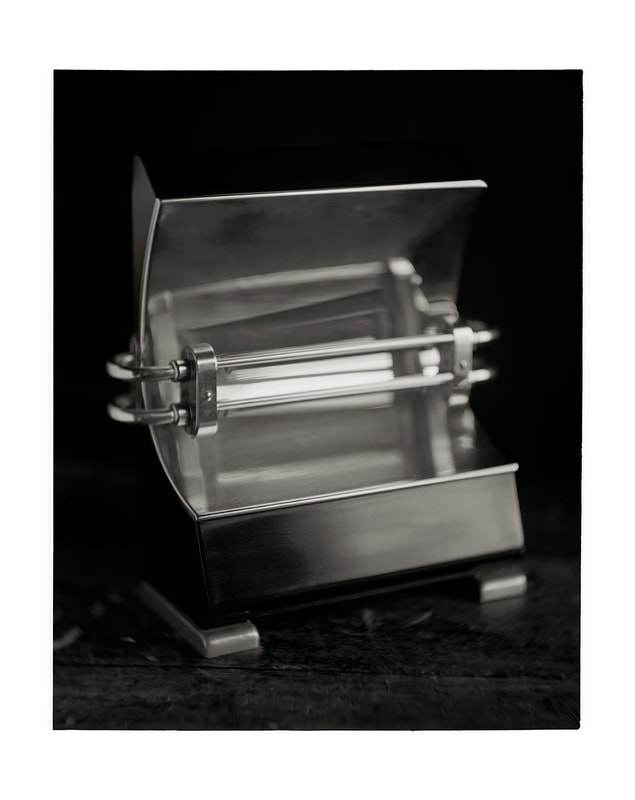|
HEAT, SALA exhibition, August 2020, the Banksia Tree Cafe, Port Adelaide.
Heat is not always the opposite of cool. As a product designer, I have always been fascinated by intrinsically beautiful, well-designed and well-engineered products. So for me, right from back when I was a student, it naturally followed that I would collect examples to have around me. I’ve also got a bit of a thing for analogue photography and the equipment and materials that can be used to produce the sometimes unpredictable and often satisfying images. One of the series I’ve been working on for some time is my kitchen table photography, where I drag something out from my collection of machine age archaeology and set it up on the kitchen table, utilising the natural early morning or dusk light from adjacent windows. The 1930s to mid-century domestic electric heaters displayed in these portraits were originally marketed towards wealthier homes that could afford the running costs of domestic power. They were designed to fit into Art Deco, Streamlined, Modernist and mid-century homes, often replacing smoky open fires. Most of the time we know the manufacturers of these products but the product designers, those who conceptualised and materialised these products, are rarely mentioned. This is my tribute to those designers who brought heat into domestic spaces with some very cool design. The photos here were taken with a large format Linhof camera from the 1950s, combined with a Dallmeyer 3C portrait brass lens from the 1880s. The negatives were developed in the laundry and hung in the shower to dry. Scans of the negatives were then printed by Atkins Photo Lab on Cotton Rag using archival inks, the prints then protected with a spray finish. Click on an image to enlarge ©Tony Kearney 2020. |
Review of HEAT by John Neylon for The Adelaide Review, August 2020
“Heat is not always the opposite of cool” – Tony Kearney
These images have been inspired, as the artist states, by a long-standing fascination with ‘intrinsically beautiful, well-designed and well-engineered products.’ Among these examples, collected and photographed by Kearney, are domestic heaters from the 1930s to the mid twentieth century. An appealing aesthetic feature, for the artist, is that they were designed to fit into Art Deco, Streamlined, Modernist and mid-century homes. They replaced the smoky fireplaces of a colonial to Depression-era past and (in wealthier homes) symbolised prosperity and modern taste.
These are no cheesy, mock-log fire items but true love children of the modern era with its embrace of new materials (such as chromed and painted steel, aluminium, Bakelite) and stream-lined minimalism. A spectacular example is a 1930s fan heater, manufactured by His Masters Voice (HMV) which looks so like a stack of. Walkman pods. For those who want to go further behind the scenes – Kearney’s foray into what he calls ‘machine-age archaeology’ has involved lots of even older-school technology – items set up on his kitchen table to catch natural early morning or dusk light, and shooting with a large format, 1950s (Linhof) camera (with a Dallmeyer 3C 1880s portrait brass lens).
Wow. To a photo/steam punk twitcher such descriptions are pure poetry. Somehow, in such company, that split cycle Panasonic unit, is never going to hold your gaze.
“Heat is not always the opposite of cool” – Tony Kearney
These images have been inspired, as the artist states, by a long-standing fascination with ‘intrinsically beautiful, well-designed and well-engineered products.’ Among these examples, collected and photographed by Kearney, are domestic heaters from the 1930s to the mid twentieth century. An appealing aesthetic feature, for the artist, is that they were designed to fit into Art Deco, Streamlined, Modernist and mid-century homes. They replaced the smoky fireplaces of a colonial to Depression-era past and (in wealthier homes) symbolised prosperity and modern taste.
These are no cheesy, mock-log fire items but true love children of the modern era with its embrace of new materials (such as chromed and painted steel, aluminium, Bakelite) and stream-lined minimalism. A spectacular example is a 1930s fan heater, manufactured by His Masters Voice (HMV) which looks so like a stack of. Walkman pods. For those who want to go further behind the scenes – Kearney’s foray into what he calls ‘machine-age archaeology’ has involved lots of even older-school technology – items set up on his kitchen table to catch natural early morning or dusk light, and shooting with a large format, 1950s (Linhof) camera (with a Dallmeyer 3C 1880s portrait brass lens).
Wow. To a photo/steam punk twitcher such descriptions are pure poetry. Somehow, in such company, that split cycle Panasonic unit, is never going to hold your gaze.






